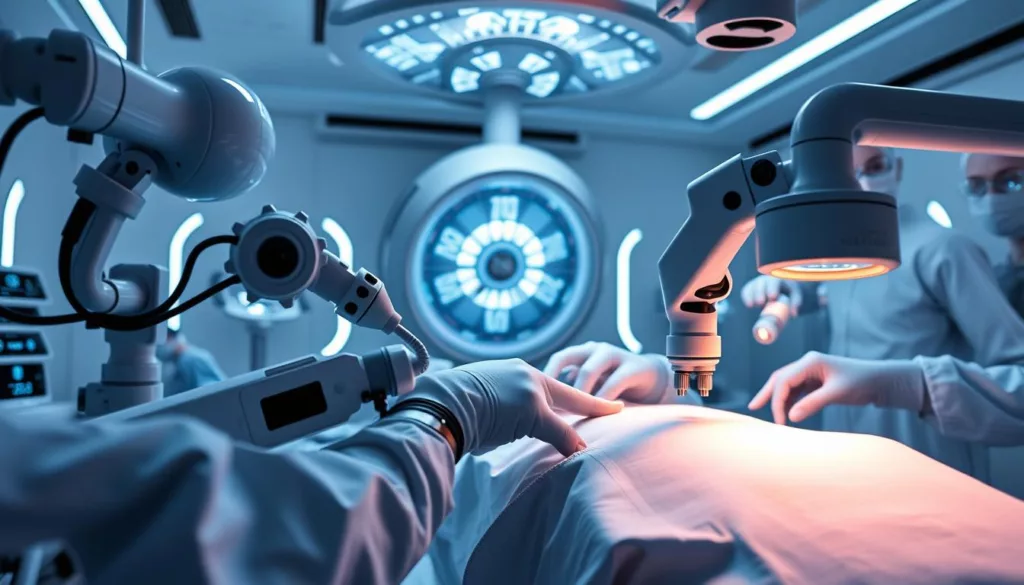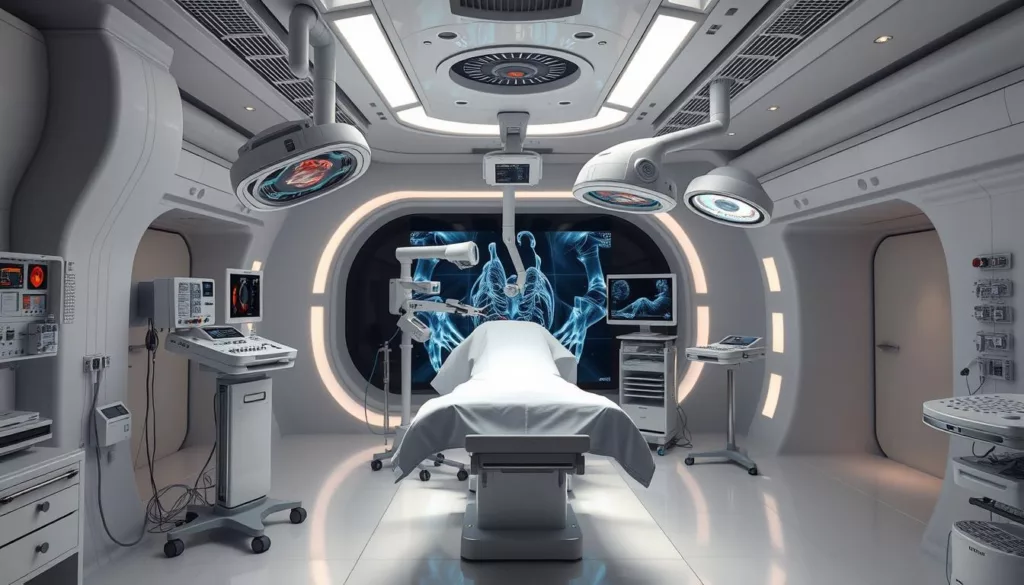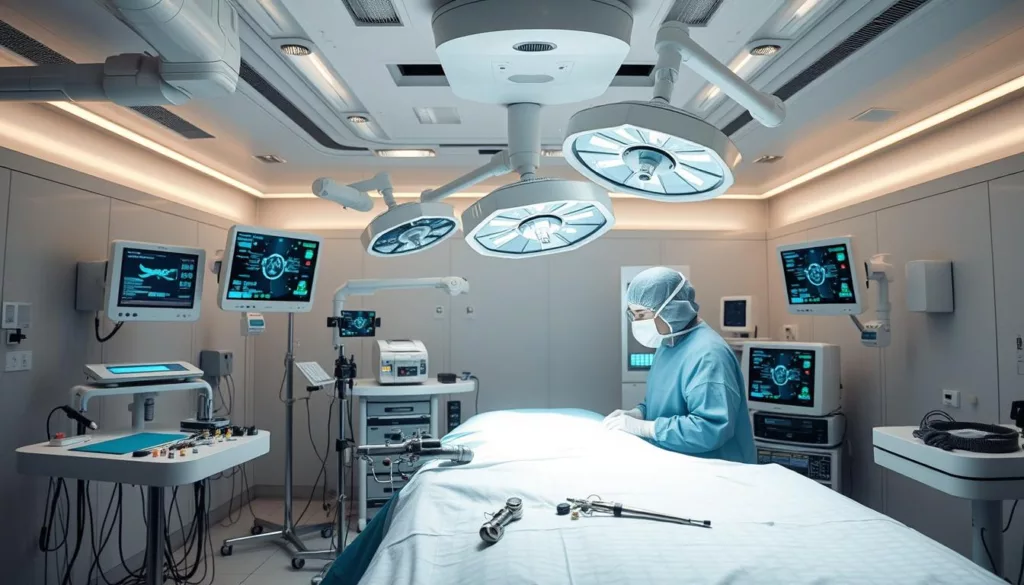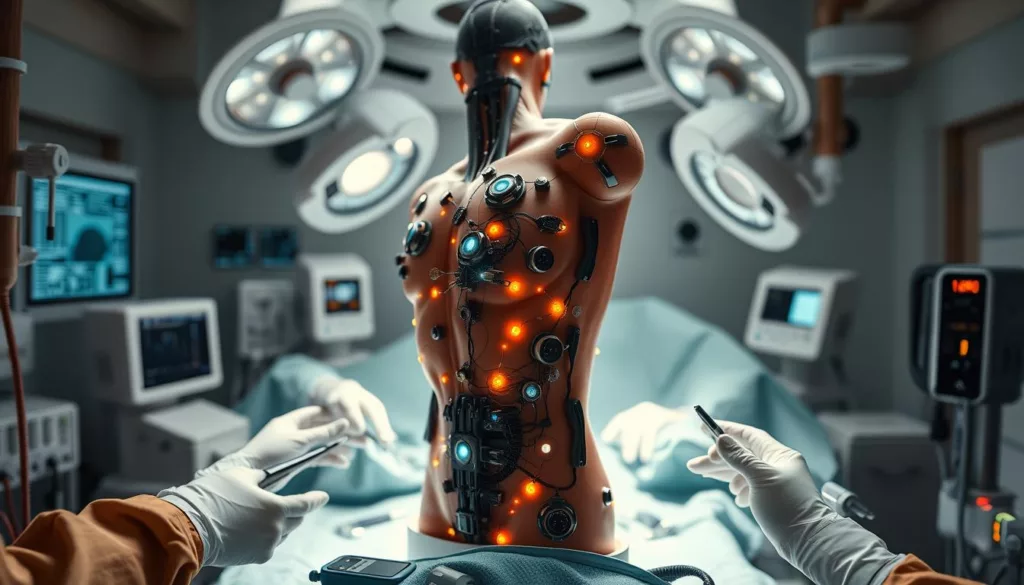In recent years, minimally invasive surgery has been transformed. This is thanks to groundbreaking sensor technology. These innovations have led to sensors that help surgeons work with amazing accuracy, making operations safer for patients. With these advanced sensors, medical teams can carry out precise surgical work. This cuts down on the harm surgery can do and speeds up recovery. We are dedicated to providing top-notch sensors for surgeries. Our focus is on innovation and quality.
Key Takeaways
- Minimally invasive surgery has greatly benefited from the latest innovations in sensors.
- Advanced surgical sensors are pivotal for enhancing precision in surgical techniques.
- These sensors contribute to shorter recovery times and decreased patient trauma.
- The focus on cutting-edge sensors for surgery drives improvement in patient outcomes.
- Ongoing research and innovation are essential to further advance sensor technology.
Overview of Minimally Invasive Surgery Techniques
Minimally invasive surgery has changed how operations are performed, focusing on the patient’s comfort and faster healing. These methods use tiny incisions, which mean less bleeding and fewer scars. This approach meets the demand for high-tech surgeries. As doctors use new technologies, these surgeries become safer and more effective.
Benefits of Minimally Invasive Approaches
The perks of minimally invasive surgery are impressive. They include:
- Quicker recovery, so patients resume daily life sooner.
- Lower infection risk, thanks to smaller incisions.
- Reduced pain after surgery, boosting patient happiness.
This leads to more doctors and patients choosing minimally invasive surgeries. It shows how surgery is advancing for the better.
Comparison with Traditional Surgery
Compared to traditional surgery, the differences are clear. Old-school surgeries need big cuts that lead to:
- More time in the hospital and long recovery.
- Higher chances of problems and infections.
- More pain after surgery.
Now, both patients and doctors prefer less invasive options. They offer more safety and comfort.
Market Demand for Advanced Surgical Techniques
There’s a big demand for cutting-edge surgical methods. Surgeons want tools that make surgeries less invasive. A good example is the use of precise load cell sensors by XJCSENSOR. They make surgeries more accurate. This is part of a move toward better and safer surgeries.
Role of Sensors in Modern Surgery
Sensors in surgery have changed the game for the better. They’re key for role of sensors in surgery, making operations more precise. They give surgeons real-time feedback, helping them make better decisions during surgeries. This leads to better results.
Enhancing Precision in Surgical Procedures
Precision is everything in surgery. Advanced surgical sensors help surgeons by:
- Accurate instrument positioning
- Dynamic assessment of tissue conditions
- Adjustments based on real-time data
This helps make surgeries safer and more effective. It is especially true for less invasive surgeries. The constant feedback reduces risks and ensures patients get the best care.
Real-time Monitoring for Better Outcomes
Real-time monitoring for minimally invasive surgeries is essential. Sensors keep track of vital signs and conditions, allowing for quick action when needed. This leads to:
- Timely intervention in critical situations
- Decreased likelihood of postoperative complications
- Improved overall patient recovery rates
To learn more about how sensors improve surgery, check out real-time feedback mechanisms.
Key Innovations in Sensor Technology
Recent advancements have led to several key innovations in sensor technology, particularly in the medical field. These innovations significantly enhance clinical practices. They improve patient outcomes and make surgeries more efficient.
The integration of sophisticated sensor technology has opened up new ways to monitor patients. It has improved surgical precision and imaging quality too.
Wearable Sensors for Patient Monitoring
Wearable sensors for patient monitoring have changed how healthcare providers track patients after surgery. These devices offer continuous monitoring of vital signs. This allows for timely interventions when needed.
They keep clinicians updated and let patients play an active part in recovery.
Advanced Imaging Technologies
The field has seen incredible growth in advanced imaging technologies. 3D imaging and augmented reality are changing the way surgeries are prepared and performed.
They provide clear imagery and better visualization. This helps surgeons work with higher precision and lowers operation risks.
Miniaturized Sensors for Targeted Use
Miniaturized sensors are crucial for minimally invasive surgeries. Their small size enables precise use in different surgical areas. This leads to less trauma and faster recovery for patients.
The use of these tiny sensors makes surgical tools more versatile. It allows for new techniques that improve patient care.
| Innovation | Description | Benefits |
|---|---|---|
| Wearable Sensors | Devices for continuous vital sign monitoring | Timely interventions; patient empowerment |
| Advanced Imaging | 3D imaging; augmented reality techniques | Enhanced surgical accuracy; reduced risks |
| Miniaturized Sensors | Small sensors for minimally invasive procedures | Less trauma; quicker recovery |
Integration of AI with Sensor Technologies
AI is changing the game in surgery with its integration into sensors. Surgeons now have real-time data at their fingertips. They can make better decisions during surgery.
AI’s predictive analytics are key in this advance. They help doctors predict problems and change their approach.
AI Algorithms for Predictive Analytics
AI algorithms use data from sensors to give insights. They find patterns in the data with machine learning. This way, surgical teams can know about possible issues early.
Case Studies of AI in Surgical Sensors
Case studies show how AI in sensors is making surgery safer. Hospitals using AI saw fewer surgical mistakes. They could plan better with data, improving surgery and recovery.
AI is essential in modern surgical methods. It’s vital as healthcare grows. AI in sensors will shape surgery’s future.
Wireless Sensor Networks in Surgical Settings
Wireless sensor networks are changing surgery for the better. They link sensors to provide instant data. This improves surgery success and keeps patients safe. Wireless tech lets devices and medical teams talk smoothly, making surgery more adaptable and effective.
Advantages of Wireless Communication
Wireless communication brings many benefits to surgery:
- Increased Mobility: Doctors and nurses can move easily, working better together without cable limits.
- Easier Data Access: The surgery team can see live data easily, without complex setups.
- Enhanced Monitoring: Ongoing checks on vital signs reduce mistakes and boost patient results.
Looking for special sensor solutions for surgery? Check out XJCSENSOR. They focus on precise, dependable options suited to your surgical needs.
Challenges and Solutions in Connectivity
However, there are hurdles to overcome with surgical connectivity:
- Interference: Outside devices can mess with signals and lower trustworthiness.
- Data Security: It’s vital to keep patient info safe from unauthorized eyes.
- Consistency in Connectivity: Keeping a stable connection during intense surgeries is tough.
To handle these, strong encryption and dependable backup systems are key. They keep data safe and ensure constant, vital info flow during operations.
| Advantages | Challenges | Solutions |
|---|---|---|
| Increased Mobility | Interference from other devices | Robust signal modulation techniques |
| Easier Data Access | Data security risks | Advanced encryption protocols |
| Enhanced Monitoring | Consistency in connectivity | Reliable backup systems |
Biocompatible Sensors in Surgery
Biocompatible sensors play a crucial role in making surgeries safer and more effective. The materials used in these sensors matter a lot because they touch human tissue. We’ll talk about important materials and some leading examples of these technologies.
Materials and Their Importance
Choosing the right materials for surgical sensors is very important. The right materials make sensors safe and reliable during surgery. They must work well with the body to keep patients healthy.
Examples of Biocompatible Sensors
There are many new types of sensors that make surgery better. Here are some key examples:
- Silicone-based Sensors: They are strong and work well with our bodies. They cause very few issues, keeping patients safe.
- Bioresorbable Sensors: These sensors break down after their job is done. This means fewer follow-up surgeries are needed.
| Sensor Type | Material | Benefits |
|---|---|---|
| Silicone-based Sensor | Silicone | Durability, tissue compatibility, minimal inflammatory response |
| Bioresorbable Sensor | Polylactic Acid (PLA) | Safe dissolution post-use, reduced subsequent procedures |
Knowing about the materials used in surgical sensors is key. It’s also important to look at successful biocompatible technologies. Both offer big insights into improving surgery.
Future Trends in Sensor Development
The world of sensor tech is growing fast, especially in areas like less invasive surgery. Looking forward, there are key trends to watch for in sensor development. They show great promise for improving healthcare. We are zooming in on surgical sensors and their exciting future. Such breakthroughs may change how surgeries are done.
Expected Innovations on the Horizon
New technologies, like nanotech, are expected to make sensors smaller and better. This can lead to higher quality data during surgeries. Sensors could become better at talking to each other too. This would improve teamwork and patient outcomes during operations.
The Role of Research and Development
Research and development are key in advancing sensor tech. It brings universities and industries together, speeding up progress. Constantly finding new materials and designs is crucial. It pushes sensor tech forward, especially for less invasive surgeries. A leader in these advancements is XJCSENSOR. They’re dedicated to creating better sensor solutions. Check out their work here to see their impact on test equipment.
| Trend | Innovation | Impact |
|---|---|---|
| Nano-sensors | Enhanced data fidelity and size reduction | Improved precision in surgical tracking |
| Integrated networks | Wireless communication for real-time monitoring | Streamlined surgical workflows and collaboration |
| Advanced materials | Biocompatibility and durability | Increased safety and longevity of sensors |
Regulatory Challenges and Approvals
Understanding the rules around new sensor tech in surgery is key. Many factors make this tough, especially the FDA’s rules for sensors. These rules make sure devices are safe and work well before they’re used in treatments.
Navigating FDA Regulations for Sensors
The steps to get surgical sensors approved include lots of tests and paperwork. Companies need to show their data meets the FDA’s rules. This shows their products are safe and effective. But, this process can take a lot of time and delay when new products come out.
Importance of Clinical Trials
It’s critical to test surgical sensors thoroughly. These tests prove sensors work well, helping them get accepted in the market. Clinical trials are really important. They’re what get a product approved and build trust with doctors and those who invest in these devices.
| Regulatory Aspect | Description | Significance |
|---|---|---|
| FDA Approval Process | Comprehensive evaluation of safety and effectiveness | Ensures market-ready devices are reliable and safe for patients |
| Clinical Trials | Testing devices in real-world clinical settings | Validates efficacy and garners support for broader adoption |
| Post-Market Surveillance | Monitoring device performance post-approval | Identifies long-term safety and effectiveness |
Case Studies of Successful Implementations
Top hospitals have started using new sensor tech in surgeries. For example, Mayo Clinic and Cleveland Clinic show how sensors improve minimally invasive operations. They prove that using modern sensors makes surgery safer and more precise.
These hospitals are setting high standards in surgical care. They show the benefits of integrating advanced sensor technologies.
Notable Hospitals Leading the Way
Mayo Clinic and Cleveland Clinic lead with cutting-edge sensor use. Their work spotlights the value of high-quality sensors in medical devices. This tech helps achieve better results in minimally invasive surgeries.
These sensors give surgeons real-time info. This leads to smarter decisions during surgeries.
Patient Outcomes and Success Rates
Using advanced sensors has greatly helped patients. It has cut down recovery times and lowered risks after surgery. Surgeons get better results with this tech.
This argues for more hospitals to use quality sensors from XJCSENSOR. To learn more, click here.






